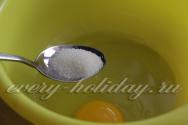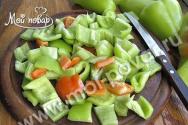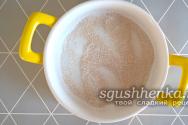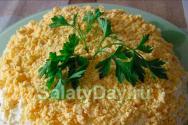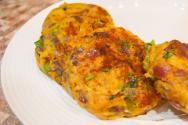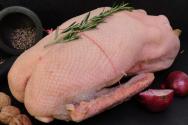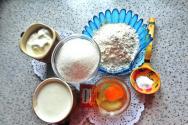Easter cupcakes (8 recipes with photos). Easter cupcake Easter cupcake the most delicious recipe
There is a huge amount of delicious yeast baked goods in the world, but you and I can recognize the taste of Easter cakes even with our eyes closed! How is Easter different from other sweets? In addition to incredible tenderness and splendor, it has a special aroma - a subtle, barely perceptible scent of citrus.
Most often, lemon zest is added to Easter cake dough: this is both more “traditional” and familiar. But the most delicious recipe is still using grapefruit zest. Easter cake with grapefruit turns out perfect! See the step-by-step recipe with photos.
Ingredients:
- eggs – 8 pcs.;
- grapefruits – 2 pcs. medium size;
- butter – 100 g;
- milk – 300 ml;
- raisins – 200 g;
- dried apricots – 150 g;
- sugar – 1.5 tbsp;
- dry yeast – 11 g;
- flour – 1 kg + how much dough will take;
- powdered sugar – 100 g;
- sweet decorations for Easter cakes - optional.
Additional accessories you will need are cake pans (metal or silicone), a sieve for sifting flour and bowls of different sizes.
How to make Easter cake
All the “salt” of Easter cakes is in the yeast. If the dough fits well, then your baking will be successful. If not, it will be heavy and not as tasty. Therefore, it is very important from the very beginning of preparing the dough to correctly “start” the tremors and allow them to turn into living foam. To do this, the yeast must be fed with sugar: on sweets, they will quickly grow and fluff up the Easter cake dough! In a small bowl, stir all the yeast with a teaspoon of sugar. Add a tablespoon of flour to this mixture, stir and add half a glass of warm (necessarily heated!) milk. Stir gently and place in a warm (and preferably sunny) place to allow the yeast mixture to rise.

While the yeast is rising, separate the yolks from the whites. To make the most delicious Easter cake you will need 5 yolks and 3 whole eggs. The remaining whites can be used to decorate baked goods if desired.

Sift the flour into a large bowl or saucepan in which you can knead the dough. This will add fluffiness to the cake.

Prepare grapefruit zest: grate the grapefruit skins using the finest grater.

The yeast is still suitable, so you can do one more part of the work in advance - grind the dried apricots. Cut it with a knife into small pieces, slightly larger than raisins.

Add the foamed yeast mass to the flour and stir lightly with a spoon. There is no need to knead until smooth. And it won’t work, because there is a lot of flour and very little liquid.

Break three eggs into the dough and add five previously separated yolks. Stir this mixture with a spoon until smooth.

Pour sugar into the bowl with the dough and stir again with a spoon.

Well, now is the time to add the fragrant grapefruit zest! Stir everything again with a spoon: at this stage the dough is not yet stiff enough to knead it with your hands.

Butter is a must-have ingredient for Easter cake if you want it to be more viscous and filling rather than dry. Melt the butter over low heat, cool it to a warm temperature and pour this mixture into the dough. Stir with a spoon.

In a separate bowl, stir raisins, dried apricot pieces and a spoonful of flour. Add this mixture to the dough and stir well. Thanks to the “coat” of flour, raisins and dried apricots will not sink to the bottom of the cake, but will stay evenly “float” in the dough. Now add flour little by little to the dough and knead it with your hands until it becomes thicker.

Place the finished dough in a bowl covered with a cotton towel in a warm place and wait until it rises. This will take at least an hour and a half. Grease the Easter cake molds with oil and place the dough in them: they need to fill about half the volume of the molds. Place the molds in a warm place so that the dough rises again in the molds. As soon as the dough has increased by one and a half times, you can safely place the molds in an oven preheated to 180 degrees and bake the cupcakes until they are beautifully golden brown. This will take from 20 minutes to an hour, depending on the size of the cakes and the power of your oven.

Take the finished cakes out of the molds and roll them on the table, placing them on their sides: otherwise the dough may settle on the sides, and the cakes will look somewhat like an hourglass. Wait until the cakes have cooled completely before frosting them!
I am sharing an interesting recipe for the so-called Jamaican cake - fragrant and very easy to prepare. The taste of the cake is reminiscent of Lenten tea baking, but instead of tea leaves, it uses syrup boiled with raisins and spices. It is this that gives baked goods their characteristic caramel color. Thanks to the bouquet of spices, the cake turns out to be spicy and slightly sweet, but it is important not to overdo it - too much cinnamon and vanilla will make the taste so bitter that it will be impossible to eat!
Will it be a full-fledged replacement for Easter cake? Of course not, this is first and foremost a cake, and a lean and yeast-free one at that. However, if you are a vegetarian or for some other reason prefer Lenten baking, the cupcake is quite suitable as an Easter cake. Yes, the structure of the dough is not so loose and porous, because there is no fermentation process, there are no eggs or butter in the composition, and there is no aroma of milk. But on a vegetarian table, a Jamaican cake, baked in the form of a cake or a ring, can take a festive place. Especially if you decorate it with a snow-white cap of icing and bright sprinkles. The recipe will also appeal to novice cooks who have not yet decided to try a rich yeast Easter cake, but really want to decorate the table with holiday pastries. You have to start somewhere, and Jamaican Vegetarian Cake is a good choice!
Total cooking time: 50 minutes
Cooking time: 30 minutes
Yield: 1 serving, 300 g
Ingredients
- wheat flour - 200 g
- water - 1 tbsp.
- raisins - 1 tbsp.
- sugar - 4 tbsp. l.
- ground cinnamon - 3 chips.
- nutmeg - 1 chip.
- vanillin - 1 chip.
- salt - 1 chip.
- baking soda - 1.5 tsp.
- vegetable oil - 1.5 tbsp. l.
- citric acid - 0.5 tsp.
Preparation

We wash the raisins, changing the water several times. Add sugar, salt, vanillin, cinnamon and nutmeg. Fill with clean cold water and place the pan on the fire.

Bring to a boil and simmer over low heat for 2-3 minutes. You can add 1 star anise to enhance the flavor (don't forget to remove it when the raisins are cooked in the syrup!). Add baking soda to the boiling aromatic mixture, stir quickly and remove the pan from the heat. When adding soda, a reaction should occur - it will foam strongly and go out after a few seconds. Cover the boiled raisins with a lid and leave to cool in the syrup for 10 minutes.
Important! If the raisins are too sweet, then the soda in boiling water may not be completely extinguished. Therefore, for insurance, add 0.5 tsp to the dough. citric acid (it can be mixed with flour). Then the baked goods will not have a soda taste.

Sift flour into a deep bowl (200 grams is 1 glass with a good top), add refined vegetable oil and pour in warm syrup with raisins.

Mix the dough thoroughly with a tablespoon until smooth. It should turn out moderately liquid, a little thicker than for pancakes.

For baking, a regular iron pan for paskas is suitable, which needs to be greased. It is very convenient to bake in special disposable paper molds that do not require lubrication. You can put a sheet of parchment paper inside so that it protrudes beyond the edges of the mold and pin it at the top with a stapler - this will prevent the “cap” of the Easter cake from burning, and the paper mold will not get oily and will look more neat.

Fill the baking pan not to the very top, leaving room for the dough to rise. Bake in a preheated oven at 180 degrees for 25-30 minutes, check readiness with a wooden skewer. In a medium tin designed for a 300-gram cake, the cap grew about 5 cm above the edge and cracked beautifully.

Let the cake cool completely in the oven and decorate with powdered sugar or icing.
Easter is the greatest Orthodox holiday in the Christian world. The Day of the Resurrection of Christ is celebrated in every family in a special way. On this holiday, housewives try to set the table richly and generously. And the main symbols and decoration of the celebration are already colored eggs and Easter cakes.
In the old days, housewives baked Easter cakes themselves, decorating them with icing and various sprinkles. Today, Easter products can be purchased at any store. Their assortment is quite large. But store-bought Easters are incomparable to homemade ones - fluffy, fragrant, made with love and soul.
Experienced and young housewives are increasingly choosing to make their own Easter cakes. The abundance of recipes allows you to find both simple options that do not require skills, as well as complex versions of Easter cake.
The content of the article:
1. Easter cake muffin simple and delicious recipe
Easter cake muffin simple and delicious recipe
The result is a soft cake that tastes like a cupcake. This recipe is ideal for housewives without experience working with dough. If necessary, the amount of flour can be reduced or increased.
Compound:
- 0.5 l of milk;
- 6 eggs;
- 250 g margarine;
- 100 g pressed yeast;
- a glass of raisins;
- 8-9 glasses of flour;
- 0.6 kg sugar;
- 50 g vegetable oil;
- vanillin.
Manufacturing algorithm:
- Boil the milk. Throw all the margarine into it and melt it.
- Cool the mass to 35-40°C, add yeast and 0.2 kg of sugar.
- Set aside for 15 minutes to allow the yeast to start playing.
- Throw eggs, raisins, vegetable oil and flour into the fermented mass.
- Knead soft dough.
- Remove the workpiece to rest in a warm place for 2 hours.
- During this time, prepare the baking tins.
- Form balls from the risen dough and place them in molds so that they fill the containers by 1/3.
- Place in a warm place so that the pieces “grow” 2-2.5 times.
- Preheat the oven to 150°C. Bake until done. Check with a wooden skewer. If the top is too browned and the dough inside is raw, it is recommended to cover the cake with parchment and continue baking until the skewer is dry.
- Cool the finished cakes, coat them with fondant and decorate with sprinkles.

This version of Easter baked goods has a more delicate texture. The cooking technology is no different from standard recipes with milk. To make the cake dough tasty, it is recommended to use only natural yogurt, without food additives or dyes.
Compound:
- 100 g natural yogurt;
- 5 tbsp. sugar in the dough;
- 1/2 tsp. salt;
- 150 ml water;
- 2.5 cups flour;
- 100 g butter;
- raisins according to preference;
- 1 tsp sugar in the dough;
- 3 yolks;
- 1 tsp without a pile of granulated yeast.
Manufacturing algorithm:
- Place yeast and a teaspoon of sugar in water (40°C). Leave in a warm place for a quarter of an hour until the yeast begins to sparkle.
- Wash the raisins and steam with boiling water. Leave to swell for 30 minutes. After this time, drain the water and roll the raisins in flour.
- Melt the butter over low heat. Cool.
- Using a mixer, mix the yolks with salt.
- Add room temperature yogurt, beaten yolks, melted butter, and sugar to the dough. Stir.
- Add sifted flour, knead sticky dough.
- Place the dough in a warm place. Let stand for about 40 minutes, knead and leave to rise again for 45 minutes.
- Gently fold the raisins into the dough.
- Grease the molds with oil. Fill the baking containers 2/3 full with dough. Leave warm to rise.
- Heat the oven to 180°C and place the cakes in it. Check the readiness of the products with a wooden skewer or toothpick.
- If the middle of the product is raw and the top is burnt, then the cake should be covered with parchment or foil.
- Cool the finished Easter eggs, spread with fondant and decorate according to your preferences.

The dough is prepared quickly, because there is no yeast in the composition. To make the product more fluffy, baking powder is added. You can bake large and small cupcakes. The finished baked goods are decorated with icing and sprinkles.
Compound:
- 1 cup flour;
- 160 g sugar;
- 0.1 l milk;
- 10 g baking powder;
- a pack of butter;
- 2 eggs;
- 70 g raisins or candied fruits;
- 0.5 tsp ground nutmeg.
Manufacturing algorithm:
- Place the butter in a bowl and leave for 20-30 minutes to soften.
- Add sugar and mix the products thoroughly, lightly rubbing the mass.
- Add eggs to the butter mixture and whisk until the ingredients are well mixed and have a uniform consistency.
- Add flour in portions while stirring the dough.
- Add baking powder and mix the mixture.
- Add ground nutmeg for flavor.
- Pour milk into the thick mass in parts and stir, achieving the consistency of thick sour cream.
- Add raisins (candied fruits) and stir.
- Grease molds (preferably silicone). Fill approximately 1/2 full with dough.
- Place in the oven at 180°C for half an hour.
- Coat the finished cupcakes with glaze and sprinkle with sprinkles.

This is a traditional cupcake that Italians prepare on Orthodox holidays. Contains a lot of candied fruits and raisins. The main difference from the usual Easter cake is the absence of a large amount of butter and eggs in the dough. It is customary to add a variety of spices to cupcakes - vanilla, nutmeg, cardamom.
Compound:
- 650 g flour;
- 1 cup raisins;
- 3 eggs;
- 2 tbsp. hot water;
- 1 tbsp. honey;
- 2 tbsp. Roma;
- 1/4 tsp. grated lemon zest;
- 0.5 tsp granulated yeast;
- 2/3 cup warm (about 25°C) water;
- 180 g sugar;
- 160 g soft butter;
- 0.5 tsp salt;
- 1 pack of vanillin;
- 2/3 cup candied citrus fruits;
- 1 tbsp each melted and cooled butter.
Manufacturing algorithm:
- Place raisins in a bowl. Pour in hot water (2 tbsp) and rum. Leave to soak, stir occasionally.
- In a deep container, mix yeast, flour, sugar, lemon zest, vanillin, salt.
- In another container, combine eggs, honey and warm water. Beat the ingredients well. Add them to the flour. Stir.
- Add soft butter and knead into an elastic dough. Wrap the container in cling film and leave for 13 hours. The dough should increase 3 times.
- Mix candied fruits, soaked strained raisins and melted butter.
- Place the dough on a floured table. Stretch the edges and place prepared candied fruits and raisins in the center. Form into a ball.
- Grease the cake tin. Place the “bun” in it, seam down. Cover the mold with a slightly damp cloth and leave the dough for another 5 hours. During this time it should rise above the edges of the container.
- Preheat the oven to 190°C.
- Make a cross-shaped cut on the top of the cake and place a spoonful of cold butter in its central part. Place the dough in the oven and bake for approximately 1 hour 15 minutes.
- Check the readiness of the product with a wooden skewer. It should be dry.
- Cool the baked panettone and decorate with fondant and sprinkles as desired.
- Store the product, wrapped in cling film, for up to 7 days.

The taste and aroma of this cupcake will definitely please your household. The cake turns out tender and cooks quickly. In the original recipe, the curd cake is decorated with gelatin glaze. But it is acceptable to use any fondant.
Compound:
- 0.4 kg cottage cheese;
- 370 g flour;
- 1 pack of butter;
- 3-4 eggs;
- 250 g sugar;
- 150 g dried apricots;
- 2.5 tsp baking powder;
- 1 tsp orange zest.
Manufacturing algorithm:
- Chop the dried apricots and remove the zest from the orange.
- Mix eggs with sugar and beat well.
- Add the cottage cheese, ground through a sieve, to the eggs and beat the products together.
- Melt the butter over low heat or in the microwave. Cool slightly. Add to the main mixture. And mix with a mixer.
- Sift flour with baking powder into a separate cup. Add in two parts to the dough. Stir.
- Add dried apricots and zest. To stir thoroughly.
- Grease a mold approximately 26 cm in diameter and dust it with flour. Place the dough into it.
- Bake in a hot (170°C) oven for 1 to one and a half hours. Towards the end of baking, pierce the product with a toothpick. If it is dry, then the cake can be removed.
- Cool the cake, decorate with icing and sprinkles.

The time spent preparing Easter cake according to this recipe pays off with the excellent taste of the baked goods. The quantity of products is designed for 2 Easter cakes. The volume of the multicooker bowl is 5 liters.
Compound:
- 1 kg flour;
- 500 ml milk;
- 50 g pressed yeast;
- 15 yolks;
- 350 g butter;
- 250 g sugar;
- vanillin;
- 200 g raisins;
- 1/2 tsp. salt.
Manufacturing algorithm:
- For the dough, mix 2 tablespoons of sugar, 2 tablespoons of sifted flour, a glass of milk heated to 40°C. Add crushed yeast. Mix the products.
- Remove the sponge mass for 1-1.5 hours in a warm place.
- Separate the whites and yolks.
- In a deep bowl, beat the yolks with sugar with a blender.
- Add the rest of the milk, vanillin, beaten yolks, and melted butter to the sponge mass that has “grown” 2-3 times.
- Gradually add flour, knead elastic but not sticky dough.
- Place a lump of dough in a bowl, cover with film and leave in a warm, draft-free place for an hour.
- As soon as the dough has risen, knead it again, adding raisins and, if necessary, a little flour.
- Divide the resulting dough into 2 equal parts.
- Place one half in a multi-cooker container. Its volume should not exceed a third of the bowl. The dough rises well during cooking.
- Keep the dough on the “Heating” mode for 60 minutes. Then press “Bake” and bake for another 60 minutes. Once the timer is up, open the slow cooker, carefully turn the cake over and bake for another 20 minutes.
- Prepare the second cupcake in the same way.
- Coat the finished products with glaze and powder or decorate according to your preferences.

The taste of Easter cake without yeast is somewhat different from the classic yeast Easter baked goods. For housewives who do not have the time or desire to tinker with yeast dough, this baking option will be an excellent alternative. To ensure that the cakes are well baked and at the same time not burnt on top, bake them at a temperature no higher than 170°C. It is worth considering that the smaller the mold, the faster Easter will be ready.
Compound:
- 0.3 l kefir, 1%;
- 330 g flour;
- 150 g sugar;
- 100 g butter;
- 1 tsp soda;
- vanillin according to preference;
- dried apricots, raisins optional.
Manufacturing algorithm:
- Pour kefir at room temperature into a container, add soda. Wait until the reaction occurs and the kefir starts to bubble.
- Sift flour into a deep bowl.
- Melt the butter and cool slightly.
- Add kefir, vanillin, sugar and butter to the flour. Stir thoroughly.
- Pour boiling water over raisins and dried apricots in advance and let sit for half an hour until they swell. Drain the water. Cut the dried apricots. Roll dried fruits in flour.
- Add raisins and dried apricots to the dough. Stir. The consistency of the dough should be thicker than for pancakes and regular muffins.
- Prepare forms. Metal molds - grease and sprinkle with flour.
- Pour in the dough, filling the container halfway.
- Place in a hot (160-170°C) oven. Bake for an average of half an hour. Check readiness with a wooden skewer.
- Cool the finished products and then decorate with icing and Easter decorations.

Easter cake with cream
Alexandria Easter cake
How to cook Easter cake with yolks and butter
Secrets of making delicious Easter cake
To ensure that Easter baked goods are truly delicious and that the dough does not settle and turn into a flat pancake, there are a number of nuances that experienced housewives recommend observing.
- All products for Easter cakes must be high quality and fresh.
- Flour must be sifted through the finest sieve at least 2 times. The more air the flour gets, the fluffier the cakes will be.
- If it is not possible to buy compressed yeast, then it is permissible to use dry granulated yeast. They are taken in the proportion of 15 g of yeast per kilo of flour.
- Yeast, whether dry or live, must be very fresh.
- The temperature of all products should be room temperature (25°C). This way they interact better.
- Draft, ventilation, excessive noise - an environment in which the dough will not be able to rise to its full potential.
- The dough should not be loose, but you also should not overdo it with flour - too high a density will not allow the product to rise. The dough is considered ready if, when cut with a knife, it does not stick to the blade.
- You need to be careful with spices. They should not overwhelm the aroma of the baking itself. You can add cardamom, nutmeg, cinnamon or vanilla. Citrus zest will add piquancy and a beautiful shade to the cake.
- The amount of filler - candied fruits and raisins - should not exceed 300 g per 1 kg of flour.
- For Easter cakes, it is necessary to rise the dough three times: dough, ready-made dough, molded pieces.
- The maximum volume of dough in the mold is 2/3 of the capacity. The dough rises several times during baking.
- It is not recommended to open the oven during baking. The Easter cake may fall and not rise.
Cooking Easter cake has always been considered a special sacrament. To get an excellent result, you need to choose a recipe that is suitable in complexity, be patient, time and have a good mood.
02.04.2017
Let's prepare delicious cupcakes for Easter!
The whole family usually gathers for Easter, so proven cupcake recipes will come in handy. You can take this dessert with you as a treat or on a picnic. Making Easter cupcakes can become a good family tradition, because everyone can prepare and decorate cupcakes in their own way. Prepare delicious Easter cupcakes and have a bright and sweet holiday!
● To speed up drying and improve the quality of the glaze, you can add 3 egg whites instead of water (i.e., replace every 1 tablespoon of water with 1 white).
● If the Easter cake sits in the refrigerator until the morning, it will be even tastier.
● To calculate the weight of a particular product, the Comparative Table of Weights and Measures will help you.
Let cooking become your favorite pastime and a wonderful hobby!

Recipe 1. Easter cake with cottage cheese and raisins
Ingredients
For the test:
✵ wheat flour (highest grade) - 280 g;
✵ cottage cheese - 260 g;
✵ chicken eggs - 3 pcs.;
✵ granulated sugar ‒ 300 g;
✵ butter - 150 g;
✵ baking powder - 15 g;
✵ raisins ‒ 80-100 g.
For the glaze:
✵ powdered sugar - 1 cup;
✵ water ‒ 3 tbsp. spoons;
✵ aromatics - optional;
✵ food coloring - optional.
Preparation
1.
Beat softened butter with sugar at high speed mixer for about 5 minutes.
2.
Add the cottage cheese and mix with a mixer.
3.
Continuing to beat, beat in the eggs one at a time.
4.
Add sifted flour with baking powder and beat at low speed.
5.
Rinse the raisins first, dry them, roll them in flour and add them to the dough.
6.
Then place the dough in a form lined with parchment paper, place in an oven preheated to 170-180°C and bake for 50-60 minutes. Check readiness with a match or toothpick.
7.
Cool the finished cake, remove it from the mold, turn it over and pour it with icing sugar or simply sprinkle it with powdered sugar.
8. For the glaze Sift the powdered sugar through a sieve into a saucepan, add warm water with aromatics and heat, stirring, to 40°. If the glaze is too thick, you need to add a little more water, and if it’s liquid, add powdered sugar. The glaze can be painted any color using natural food coloring.
Bon appetit and festive mood!

Recipe 2. Easter cake with tangerines
Ingredients:
✵ wheat flour (highest grade) - 1 cup;
✵ starch ‒ 1 tbsp. spoon;
✵ chicken eggs - 3 pcs. large or 4 pcs. small;
✵ granulated sugar - 1 cup;
✵ salt - 1 pinch;
✵ tangerines - 3 pcs.;
✵ butter - 2 tbsp. spoons (for greasing the mold);
✵ powdered sugar - for sprinkling.
Preparation
1.
Peel the tangerines, divide into slices and cut into pieces.
2.
Carefully separate the egg yolks from the whites. Place the whites in the refrigerator for now. Grind the yolks with 1/2 cup of sugar until almost white (the sugar should dissolve), and then beat with a mixer until fluffy.
3.
Lightly salt the egg whites, beat until stiff and, continuing to beat, gradually add the rest of the sugar. 
4.
Combine the beaten egg yolks and whites, stirring gently in one direction, add the sifted flour and starch and mix everything carefully, trying not to extinguish the foam.
5.
At the end of kneading the dough, add pieces of tangerines.
6.
Grease the mold with butter, lightly sprinkle with flour, pour the dough into it, place in an oven preheated to 180-190°C and bake for 25-30 minutes (you can check readiness with a toothpick). 
7.
Allow the finished Easter cake to cool, then carefully remove it from the mold and sprinkle the entire surface with powdered sugar through a strainer.
Bon appetit and Happy Easter!

Recipe 3. Easter tangerine cupcake
We present you a recipe for a simple but unusual Easter dessert. An incredibly tasty and aromatic citrus cake with glaze is prepared in just half an hour.
Ingredients:
✵ wheat flour (highest grade) - 320 g;
✵ chicken eggs - 5 pcs.;
✵ baking soda - 12 g;
✵ granulated sugar ‒ 260 g + 2 tbsp. spoons for icing;
✵ salt - 10 g (1 pinch);
✵ vegetable oil - 120 ml;
✵ tangerines - 6 pcs. large or 8 pcs. small;
✵ tangerine zest - 1 tbsp. spoon.
Preparation
1.
Squeeze the juice from the tangerines and strain. The juice will go into the dough, but don’t forget to leave 2 tbsp. spoons to prepare the glaze!
2.
Carefully separate the egg yolks from the whites. Place the whites in the refrigerator for now. Grind the yolks with sugar, and then add vegetable oil, tangerine juice with zest and beat with a mixer, gradually adding sifted flour and soda.
3.
Separately, beat the chilled egg whites with salt into a thick foam, combine with the main mixture, and carefully mix with a spatula. 
4.
Grease a cake pan, sprinkle with flour, fill halfway with dough, place in an oven preheated to 160-180°C and bake for 30 minutes.
5.
Preparing the glaze. Connect 2 tbsp. spoons of sugar and 2 tbsp. spoons of tangerine juice and place in a water bath until the sugar is completely dissolved. 
6.
The Easter cake needs to be glazed 5 minutes before it’s ready. You can also sprinkle with small colorful decorations or candied fruits.
Cook with pleasure and enjoy the taste!

Recipe 4. Easter cakes with yeast
We bring to your attention a universal recipe that can be used to bake not only Easter cakes, but also small cupcakes for Easter. The dough for Easter cupcakes is prepared with yeast, using dough, in the usual way. Due to the fact that the recipe contains butter and sour cream, the result is an excellent, rich pastry. You can use raisins or any candied fruits as fillings for Easter cupcakes. Easter cupcakes always turn out very beautiful, tasty, fragrant and festive.
Ingredients
For the test:
✵ wheat flour (highest grade) - 450-500 g;
✵ milk - 200 ml;
✵ dry yeast - 1 sachet (11 g);
✵ sour cream - 100 g;
✵ butter - 200 g;
✵ chicken eggs - 4 pcs.;
✵ granulated sugar ‒ 180-200 g;
✵ salt - 1 pinch;
✵ vanilla sugar - to taste;
✵ raisins (or candied fruits) - optional.
For the glaze:
✵ powdered sugar - 1 cup;
✵ egg white - 1 pc.;
✵ lemon juice ‒ 2 tbsp. spoons;
✵ multi-colored sprinkles - for decoration.
Preparation
1.
For the dough, dilute dry yeast and 1 tbsp. a spoonful of sugar in a small amount of warm milk, leaving for a while. When everything is activated and the fluffy cap rises, add another half of the milk and about 100 g of flour, knead the dough and leave for 30 minutes in a warm place.
2.
Lightly melt the butter and mix with sugar until completely dissolved.
3.
When the dough has risen, add the rest of the ingredients, knead a thin yeast dough and leave it for 1 hour in a warm place to rise.
4.
If raisins are used, they should be washed well, dried with a paper towel (or rolled in flour), added to the risen dough and mixed well.
5.
Place the finished dough into muffin tins. Don’t be embarrassed by the fact that the dough turns out thin - it’s not scary. It will rise very well, so the molds should be filled no more than halfway so that it does not overflow during baking.
6.
Let the dough rest in the molds for 20 minutes, then place in an oven preheated to 180-190°C and bake small cupcakes for about 30 minutes.
7. For the glaze:
Beat the chilled egg white into a strong foam, gradually adding powdered sugar. And only at the very end add lemon juice.
8.
Cover the finished Easter cupcakes protein glaze and decorate with small multi-colored sprinkles.
Happy experimenting and bon appetit!

Recipe 5. Easter Coconut Cupcakes
We offer you to prepare a delicious Easter dessert: vanilla cupcakes with cream cheese cream and coconut flakes.
Ingredients
For the test:
✵ wheat flour (highest grade) - 200 g;
✵ baking powder - 1.5 teaspoons;
✵ fresh milk - 120 ml;
✵ chicken eggs - 2 pcs.;
✵ butter - 115 g;
✵ granulated sugar ‒ 200 g;
✵ salt - 0.5 teaspoon;
✵ lemon zest - 1 teaspoon;
✵ vanilla extract - 1 teaspoon.
For the glaze:
✵ powdered sugar - 300 g;
✵ milk (or cream) - 1 tbsp. spoon;
✵ butter - 55 g;
✵ cream cheese (soft) - 115 g;
✵ vanilla extract - 0.5 teaspoon.
For decoration :
✵ coconut flakes - 2 cups;
✵ egg-shaped candies (“M&M’s” or “Robin Eggs”).
Preparation
1.
In a separate bowl, mix sifted flour, baking powder, salt and lemon zest.
2.
Beat the softened butter with a mixer for 1-2 minutes. Add sugar and beat for another 3-4 minutes at medium speed. While continuing to beat, beat in the eggs one at a time and add vanilla extract.
3.
Then, stirring with a mixer at low speed, gradually add the flour mixture (in 3 additions) and milk (in 2 additions), starting and ending with the flour. You should get a homogeneous mass.
4.
Lightly grease muffin cups (12 pcs.) or line with parchment and fill halfway with dough.
5.
Place the filled molds in an oven preheated to 180°C and bake for 18-20 minutes (check readiness with a toothpick: it should be dry).
6.
Remove the finished muffins from the oven and cool completely on a wire rack.
7. For the glaze
beat the softened butter with a mixer. Continuing whipping, first add soft cream cheese, then sugar and vanilla extract. Then add a little milk (cream) and beat until smooth.
8.
Using a silicone brush, coat each cupcake with frosting, sprinkle generously with coconut flakes and decorate with small multi-colored egg-shaped candies (“M&M’s” or “Robin Eggs”).
These cupcakes can be stored in the refrigerator for several days. But before serving, they need to be brought to room temperature.
Bon appetit and success in the culinary field!

Recipe 6. Easter cupcakes with raisins
Easter pastries have always been a table decoration for Easter. Traditionally, Easter cake, painted eggs, and Curd Easter. Not everyone can bake Easter cakes from yeast dough, but delicious airy cupcakes covered with protein icing can easily replace them. The advantages of such a dessert are its originality and taste.
Ingredients
For the test:
✵ chicken eggs - 2 pcs. + 1 yolk;
✵ sour cream (or kefir) - 100 g;
✵ butter (or margarine) - 100 g;
✵ seedless raisins (candied fruits, dried apricots) - 100 g;
✵ baking powder - 2 teaspoons;
✵ salt - 1 pinch.
For the glaze:
✵ powdered sugar - 160-180 g (1 cup);
✵ lemon juice (freshly squeezed) - 1 teaspoon;
✵ egg white ‒ 1 pc.
For decoration :
Preparation
1.
Sort the raisins and soak in hot water for 15-20 minutes so that they swell a little. Then dry it lightly on a paper towel and roll in flour. This is done so that the raisins do not sink to the very bottom during baking, but are evenly distributed throughout the product.
2.
In a deep bowl, beat 2 whole eggs and 1 yolk into a foam and grind with sugar (leave 1 white for preparing the glaze). Continuing to beat, add softened butter. The mixture should be homogeneous or with small lumps of oil. 
3.
Then add sour cream, baking powder, salt, vanilla sugar and beat the ingredients for a few minutes.
4.
Gradually add sifted flour into the resulting homogeneous mass, stirring constantly. The dough should not be stiff: it should barely slide off a spoon.
5.
At the end of the kneading, add the prepared raisins and mix thoroughly with a spoon from bottom to top. 
6.
Grease steel muffin tins (silicone and paper ones do not need this), fill a little more than half with dough (otherwise the muffin will have nowhere to rise), place in a cold oven, set the temperature to 180°C and bake for about 30 minutes. You can check readiness with a match or a toothpick (by inserting it into the baked goods, it should come out dry).
7.
Remove the finished muffins from the oven and leave to cool. 
8. For the glaze:
beat the chilled egg white, but not to stiff peaks. Then gradually add powdered sugar in small portions and finally add freshly squeezed lemon juice.
9.
Cover the cupcakes with egg white glaze and decorate with colorful sprinkles on top.
After the glaze has hardened, the Easter dessert can be served on the holiday table.
Happy baking and holiday cheer!

Recipe 7. Easter cupcakes with cottage cheese and cherries
For Easter, along with traditional rich Easter cakes, you can also prepare small, neat Easter cakes - ordinary muffins made from curd dough with a delicious filling. And giving them an “Easter outfit” of egg white icing and multi-colored sprinkles won’t be too difficult.
Ingredients:
✵ wheat flour (highest grade) - 200 g (1.5 cups);
✵ cottage cheese (homemade) - 200 g;
✵ chicken egg - 1 pc.;
✵ butter (softened) - 100 g;
✵ granulated sugar ‒ 180-200 g (1 cup);
✵ vanilla sugar - 8 g (1 teaspoon);
✵ baking soda - 0.5 teaspoon;
✵ salt - 1 pinch.
For filling :
✵ cherries (frozen berries) - to taste.
For decoration :
✵ protein glaze;
✵ multi-colored confectionery sprinkles.
Preparation
1.
Thaw the cherries. After the juice has drained, remove the seeds.
2.
Grind the softened butter with granulated sugar, soda, vanilla sugar, a pinch of salt and a chicken egg. 
3.
Place the cottage cheese into the resulting oil mass and mix thoroughly until the lumps disappear.
4.
Add sifted flour and knead thoroughly. You need to achieve the consistency of very thick sour cream. Having added the specified amount, you may need more - because each time it turns out differently due to the size of the egg and the fat content of the cottage cheese. 
5.
First put 2 teaspoons of dough into tin or silicone muffin tins, then 1 teaspoon of cherry filling, and again 2 teaspoons of dough on top. It is advisable to use silicone molds, because... products do not burn in them and are easily removed from them. 
6.
Place the filled molds in an oven preheated to 180°C and bake for 30 minutes.
7.
Once the cupcakes have cooled, you can decorate them to your liking and serve as Easter cakes. The main thing here is to arm yourself
